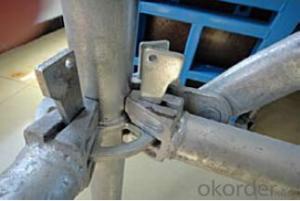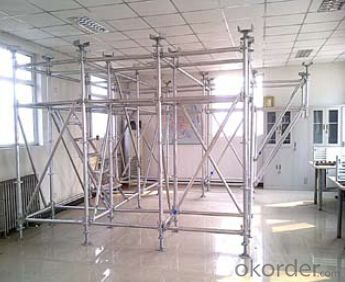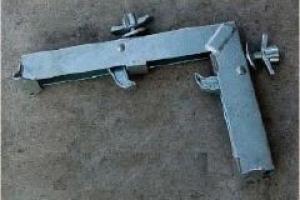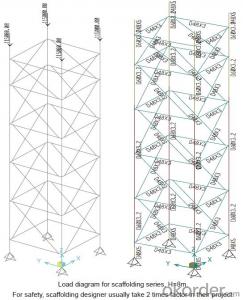Ring-lock Scaffolding Accessories for formwork and scaffolding system
- Loading Port:
- Tianjin
- Payment Terms:
- TT OR LC
- Min Order Qty:
- 50 m²
- Supply Capability:
- 1000 m²/month
OKorder Service Pledge
Quality Product, Order Online Tracking, Timely Delivery
OKorder Financial Service
Credit Rating, Credit Services, Credit Purchasing
You Might Also Like
Ring-lock Scaffolding
A support system for construction, ownsadvantages of both cup-lock scaffolding andshoring tower.
It is in the development direction of new typescaffolding.
It is widely used in buildings, bridges, tunnels etc..
Characteristics:
◆ Easy to storage and transportation
◆ High degree of standardization
◆ Easy and quick erection
◆ Excellent stability and bearing capacity
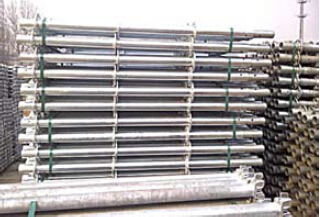
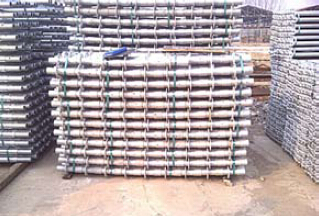
- Q: Can steel formwork be used in areas with extreme temperature variations?
- Yes, steel formwork can be used in areas with extreme temperature variations. Steel is known for its durability and strength, which allows it to withstand various temperature conditions. However, it is important to consider potential expansion and contraction of the steel due to temperature changes, and take appropriate measures to prevent any negative effects on the formwork structure.
- Q: What are the typical safety precautions when working with steel formwork?
- To ensure the safety of workers and prevent accidents, it is important to adhere to various safety measures when working with steel formwork. These measures include: 1. Personal Protective Equipment (PPE): Workers must wear the appropriate PPE, such as hard hats, safety goggles, gloves, and steel-toed boots, to protect themselves from falling objects, flying debris, and foot injuries. 2. Training: Workers should receive proper training on the safe use of steel formwork and be aware of the potential hazards associated with the equipment. They should also be educated on proper lifting techniques and the handling of heavy steel components. 3. Inspection: Before commencing work, a thorough inspection of the steel formwork should be conducted to identify any defects, damage, or weak points. Any faulty or worn-out components must be replaced immediately to prevent accidents or collapses. 4. Secure Anchoring: It is crucial to securely anchor the steel formwork to prevent shifting or collapsing during construction activities. Sufficient bracing and supports should be in place to ensure stability and avoid unexpected movements. 5. Proper Handling and Lifting Techniques: Workers should employ appropriate lifting techniques when handling heavy steel components to prevent strains, back injuries, or accidents. The use of mechanical aids, such as cranes, hoists, or forklifts, should be considered to minimize the risks associated with manual handling. 6. Fall Protection: When working at heights, appropriate fall protection measures, such as guardrails, safety harnesses, or safety nets, should be utilized to prevent falls and injuries. 7. Communication and Signage: Clear communication among workers is vital to avoid accidents. Adequate signage should be displayed to indicate the presence of steel formwork, potential hazards, and restricted areas. 8. Regular Maintenance: Regular maintenance and inspections of the steel formwork should be carried out to ensure its structural integrity. Any identified issues should be promptly addressed to prevent accidents or failures. 9. Emergency Preparedness: Workers should be familiar with the emergency procedures in place, including the location of first aid kits, fire extinguishers, and evacuation routes. Regular drills and training sessions should be conducted to ensure workers are prepared for potential emergencies. By adhering to these safety precautions, the risk of accidents, injuries, and property damage when working with steel formwork can be significantly reduced, thereby creating a safer working environment for all involved.
- Q: What are the common quality control measures for steel formwork systems?
- Steel formwork systems commonly undergo several quality control measures to ensure their effectiveness and safety in construction projects. These measures include: 1. Visual assessment: A thorough examination of the steel formwork system's condition is conducted to identify any noticeable defects, such as dents, cracks, or deformations. Damaged or compromised components must be promptly repaired or replaced. 2. Measurement and dimensional verification: Ensuring accurate measurements and dimensional alignment of steel formwork components is crucial. This is achieved by utilizing precise measuring tools and equipment to guarantee a proper fit. 3. Inspection of welded joints: Since welded joints are often used to connect various components of steel formwork systems, it is vital to conduct comprehensive inspections to detect any defects, like cracks or incomplete penetration. Non-destructive testing methods, such as visual inspection, ultrasonic testing, or magnetic particle testing, may be employed to evaluate the weld quality. 4. Load testing: To validate the structural integrity and load-bearing capacity, load testing is performed. This procedure involves applying a predetermined load to the system and evaluating its performance under stress. It helps identify any weaknesses or defects that could compromise the formwork's safety and stability. 5. Examination of surface finish: The surface finish of steel formwork systems must be smooth and devoid of roughness or irregularities that could affect the quality of the concrete finish. Inspections are carried out to ensure that the formwork surfaces are adequately cleaned, treated, and coated, if necessary. 6. Documentation and traceability: It is imperative to maintain proper documentation and traceability of the steel formwork system components. This includes keeping records of inspections, repairs, replacements, and other pertinent information. Proper documentation ensures timely and accurate resolution of any issues or concerns that may arise. These quality control measures are indispensable for guaranteeing the durability, safety, and performance of steel formwork systems in construction projects.
- Q: How does steel formwork contribute to the overall aesthetics of a structure?
- Steel formwork, a versatile and durable construction material, plays a vital role in shaping a structure's aesthetics. Its impact on a building's visual appeal is evident in various ways. Firstly, steel formwork enables the achievement of precise and intricate designs. The flexibility and strength of steel empower architects and designers to create complex shapes and unique forms that would be difficult or impossible with other materials. This ability to generate innovative and captivating designs enhances a structure's visual appeal, distinguishing it from its surroundings. Furthermore, steel formwork ensures a smooth and flawless concrete surface. The accurate manufacturing of steel panels guarantees a seamless appearance without any gaps or imperfections. This refined finish enhances the overall aesthetics of the structure, providing it with a sleek and contemporary look. Moreover, steel formwork allows for the creation of larger uninterrupted spans and open spaces. The strength of steel enables the construction of thinner and lighter elements, like slabs and beams, without compromising structural integrity. This characteristic grants architects the freedom to design structures with expansive windows, open floor plans, and abundant natural light. These features not only enhance a building's functionality but also contribute to its aesthetic appeal by creating a sense of spaciousness and connection with the environment. Additionally, steel formwork offers the advantage of reusability, significantly reducing construction waste and environmental impact. This sustainability aspect aligns a structure with modern principles of eco-friendly construction, further enhancing its overall aesthetics. The use of steel formwork demonstrates a dedication to sustainable design practices, increasing the perceived value and attractiveness of a building to potential occupants and investors. In conclusion, steel formwork contributes to a structure's aesthetics through its facilitation of intricate designs, provision of a smooth finish, creation of larger open spaces, and support of sustainable construction practices. Its versatility and durability make it an ideal choice for architects and designers seeking visually appealing and distinct structures.
- Q: What are the different types of formwork corner solutions used in steel formwork?
- Steel formwork utilizes various types of formwork corner solutions, each offering unique advantages and suitability for different construction projects. The following are some commonly used types: 1. Internal Corner Solutions: These solutions are employed to produce internal corners with a 90-degree angle within the formwork. Typically, they incorporate corner brackets or angle brackets that securely attach to the steel formwork panels. These brackets provide stability and support to the formwork system, guaranteeing accurate concrete pouring without any leakage. 2. External Corner Solutions: These solutions are utilized to create external corners with a 90-degree angle within the formwork. Generally, they consist of corner brackets or external corner connectors that are affixed to the steel formwork panels. These connectors ensure stability and reinforcement of the formwork system, facilitating precise concrete pouring without any leakage. 3. Adjustable Corner Solutions: These solutions allow for the creation of corners of varying angles in the formwork system. Often, they comprise adjustable corner brackets or connectors that can be modified to attain the desired angle. Such solutions are particularly beneficial when constructing structures with irregular or non-standard angles. 4. Corner Chamfer Solutions: These solutions enable the formation of chamfered corners within the formwork system. Typically, they involve chamfer strips or corner chamfer connectors that are attached to the steel formwork panels. These solutions permit the creation of beveled edges in the concrete, resulting in a more aesthetically pleasing finish for the structure. 5. Corner Formwork Solutions: These specialized formwork systems are specifically designed for corner creation in construction projects. They typically consist of pre-fabricated corner panels or corner formwork molds that can be easily assembled on-site. These solutions offer a quick and efficient method to construct corners within the formwork system, saving time and labor. Ultimately, the selection of a suitable formwork corner solution depends on specific project requirements, such as the desired corner angle, structural complexity, and desired finish. It is crucial to thoroughly evaluate the available options and choose the most appropriate solution to ensure a successful and efficient construction process.
- Q: Can steel formwork be used for commercial construction projects?
- Yes, steel formwork can be used for commercial construction projects. Steel formwork offers durability, strength, and the ability to withstand heavy loads, making it a suitable choice for large-scale construction projects such as commercial buildings. It provides a stable and reusable solution that allows for efficient and precise concrete placement, ensuring high-quality results.
- Q: Can steel formwork be used in areas with high seismic activities?
- Yes, steel formwork can be used in areas with high seismic activities. Steel is known for its strength and durability, making it a suitable material for construction in earthquake-prone areas. Steel formwork has the ability to withstand the lateral forces and vibrations generated by seismic activities, ensuring the safety and stability of the structure. Additionally, steel formwork is highly flexible and can be easily designed to accommodate different shapes and sizes, allowing for customized construction solutions in high seismic areas. Overall, steel formwork is a reliable and effective choice for construction projects in regions with high seismic activities.
- Q: What are the different types of formwork anchors used in steel formwork?
- Steel formwork commonly uses various types of formwork anchors to secure the formwork to the structure and ensure construction process stability and safety. Examples of these formwork anchors include: 1. Wedge Anchor: This anchor has a threaded rod with a wedge-shaped end. By inserting it into a pre-drilled hole in the concrete structure and tightening a nut on the threaded end, a strong grip is formed. It is commonly used to secure formwork to concrete walls or slabs. 2. Screw Anchor: Also known as self-tapping anchors, these anchors are designed for use in softer materials like wood or light-gauge steel. They have a threaded body that can be screwed into the material, providing a secure connection for the formwork. Screw anchors are popular for temporary formwork applications due to their easy installation and removal. 3. Hook Anchor: This hook-shaped anchor is typically embedded into the concrete structure during the pouring process. The formwork is then attached to the hook using bolts or fasteners, creating a strong and reliable connection. Hook anchors are commonly used in applications with high loads or lateral forces. 4. Swift Lift Anchor: Specifically designed for lifting and handling precast concrete elements, including steel formwork, these anchors are embedded into the structure during pouring. They provide a safe and efficient method for lifting and positioning the formwork. 5. Plate Anchor: Plate anchors consist of a flat plate with holes for bolts or fasteners. They are versatile and commonly used in steel formwork systems to secure the formwork to the structure. Plate anchors can be easily adjusted or relocated as needed. 6. Chemical Anchor: Chemical anchors are used when a strong and permanent connection is required. They consist of a resin or adhesive injected into a pre-drilled hole in the concrete structure. The steel formwork is then attached to the chemical anchor, creating a secure bond. Each type of formwork anchor has unique advantages and is suitable for different applications. Factors such as the type of structure, load requirements, and duration of use should be considered when selecting the appropriate anchor and ensuring proper installation for the safety and stability of the formwork system.
- Q: Are there any specific building codes or regulations related to steel formwork?
- Yes, there are specific building codes and regulations related to steel formwork. These codes and regulations are put in place to ensure the safety, stability, and integrity of structures constructed using steel formwork. One of the most widely recognized codes is the International Building Code (IBC), which provides minimum requirements for the design, construction, alteration, and maintenance of buildings and structures. The IBC includes provisions for formwork systems, including steel formwork, to ensure they meet certain standards of strength, durability, and stability. In addition to the IBC, several other organizations and agencies provide guidelines and standards for steel formwork. For example, the American Concrete Institute (ACI) has a document called ACI 347-04, Guide to Formwork for Concrete, which provides recommendations for the use of various types of formwork, including steel formwork. These codes and standards cover various aspects of steel formwork, including design, materials, construction, and inspection. They address issues such as the maximum allowable loads, proper bracing and shoring, formwork connections, and the quality of materials used. They also provide guidance on safety measures, such as fall protection, to ensure the well-being of workers during formwork installation and removal. It is important for builders, designers, and contractors to be familiar with these codes and regulations to ensure compliance and to guarantee the structural integrity and safety of buildings constructed using steel formwork. Local building departments and authorities having jurisdiction can provide specific information and requirements related to steel formwork in their respective regions.
- Q: Can steel formwork be used for elevated slabs?
- Yes, steel formwork can be used for elevated slabs. Steel formwork offers strength, durability, and flexibility, making it suitable for supporting the weight of the concrete and providing the necessary structural support for elevated slabs. Additionally, steel formwork can be easily assembled, disassembled, and reused, making it a cost-effective and efficient choice for constructing elevated slabs.
Send your message to us
Ring-lock Scaffolding Accessories for formwork and scaffolding system
- Loading Port:
- Tianjin
- Payment Terms:
- TT OR LC
- Min Order Qty:
- 50 m²
- Supply Capability:
- 1000 m²/month
OKorder Service Pledge
Quality Product, Order Online Tracking, Timely Delivery
OKorder Financial Service
Credit Rating, Credit Services, Credit Purchasing
Similar products
Hot products
Hot Searches
Related keywords
